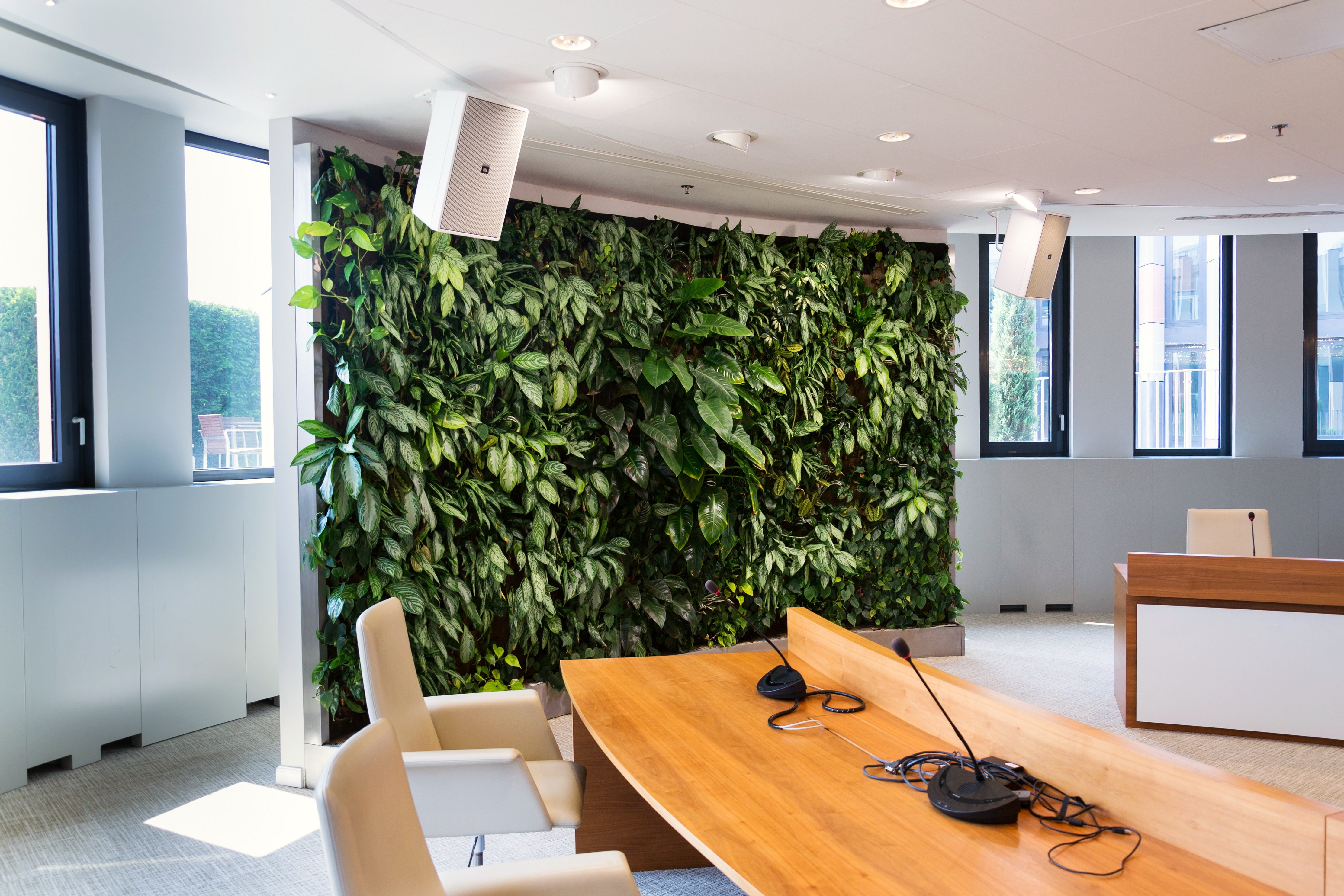The open office has been criticized as a workplace design that causes stress for employees. Some of the primary concerns include an increase in anxiety, increase in employee illness and sick leave, the lack of privacy, and reduced productivity. Plantscaping (also called interior landscaping or interiorscaping) enhances the workplace by adding plants and other features that benefit our workplaces in many ways. It is my belief that the benefits of plantscaping can offset some of the common problems found in open offices.
It has been long documented that experiences with nature can improve our health and help reduce stress. There are veterans with PTSD who are hiking long-distance trails to heal themselves by becoming immersed in nature. Nature has also been used to combat depression and other mental mood disorders. Nature has a rejuvenating and restorative power. This power can be brought indoors to help our offices be healthier, more productive, and less stressful.
I remember going to the doctor as a child and sitting in a waiting room that was painted green. Wooden chairs with no cushions lined the walls and there were magazines and children’s books on a small table. The doctor was our family doctor and I found myself there on a routine basis for illnesses and injuries. One day, I went to the doctor when I had the flu. When I entered the waiting room, I was surprised to see wallpaper lining the room with a forest scene. Plants, both large and small, had also been added to the room. There were new chairs with comfortable cushions, and the children’s books included stories of animals in the forest – almost like I was reading about the surrounding scene. The room felt completely different. I remember just sitting in the chair following the scene around the walls, looking for animals both visible and hidden and taking in the colors of the different trees and plants. The whole feeling of the room was peaceful and, while I was waiting, I nearly forgot about feeling ill or the dread of possibly getting a shot!
My doctor’s office serves as an example of how nature can transform interior space. This notion is promoted by plantscaping, which is trending now but has been around since the 1970s. The central idea is that we are becoming increasingly disconnected from nature. Bringing plants and natural features indoors is a way for us to be more connected and to receive some of the positive benefits of nature. This is true for our homes as well as our places of work and, as discussed below, may help mitigate some of the ills of the open office.
Distribute Plants throughout the Office
Plants help clean the air to keep employees healthier, produce more oxygen to help employees be more alert and productive, and add a calming influence to reduce stress. Plants also absorb sound, which can help make an open office quieter and less distracting. The following points promote ways that plants can be effective in the open office:
- Small plants can be placed on individual workstations and larger plants can be placed in underutilized corner spaces and in employee lounge areas, break rooms, and cafeterias. Note that size does matter when it comes to the benefits of plants, so use larger plants in larger spaces.
- Rows of planter boxes can be used to separate areas of the office. Plants can be used as a divider between operational divisions or formal and informal work areas, and around areas zoned for quieter workspaces.
- “Plant walls” (shown in the image above) are trending. They not only provide us with the benefits of plants, but they are also decorative and can serve as healthy office artwork.
- Place multiple plants, both floor and hanging plants, in a quieter area of the office to provide an escape from the open office into a relaxing environment where employees can de-stress in natural surroundings.
Use Water Features
Office water features can range from a small natural display to a large internal water wall. Water features provide soothing sounds and make eye-catching displays in the open office. In dry climates, they can add humidity to the air and reduce the need for humidifiers.
Small water features can be used as a calming influence in quieter areas of the office. A large display, like a water wall, can be used as an attraction, but can also mask open office sounds.
Many open offices have opted for white noise to cover up noisy distractions. Flowing water can be used for the same purpose. I have worked in offices that have piped water and natural sounds on speakers in lieu of the constant static of white noise.
Here are some open office ideas for water features:
- Create a calming area with a small water feature where employees can relax and get a break from the more distracting noise in the open office.
- Use a water feature mixed with plants as a central exhibit in lieu of artwork. Such a natural area is innovative and captivating.
- Implement a large water wall to mask sound in the open office. The effects can be spread to an entire office using a sound system that subtly plays sounds similar to the water feature in the background.
Is Plantscaping Worth It?
In addition to plants and water features, there are many other ways of introducing nature into the open office. Such ways can include natural artwork, daylighting, maximizing natural views out of office windows, and the use of materials like wood and stone in interior office construction. But a central question remains: is plantscaping worth the expense?
I believe that there is a business case that can be made for plantscaping. Here is a summary of findings supporting the notion that plantscaping can improve employee productivity and health, both of which impact the bottom-line of businesses:
- A small Australian study, conducted in 2010, found that when plants are introduced to the workplace, there was a corresponding 37% decrease in tension and anxiety, a 58% decrease in depression, a 44% decrease in anger, and a 38% reduction in fatigue.
- A 2014 study found that when plants are placed in “lean” work environments, employees scored higher on participant tests signifying an improvement in memory retention.
- A 2015 multi-national study found that employees who work in environments with natural elements had survey scores that were 15% higher on well-being and 6% higher on productivity compared to employees that did not have natural environments in their places of work.
- A small 1990s Norwegian study found that the introduction of plants to an office resulted in a 25% decrease in symptoms of ill health, which included fatigue at work, headaches, concentration problems, coughs and dry/sore throats, and irritation from dry skin.
Plantscaping can reduce stress, help employees be happier, reduce office sickness, and increase productivity. What business would not want to promote a happier and more productive workforce, not to mention spaces and features that are more attractive?
Amazon Gets It
High-tech industries like Amazon, Google, and Facebook have led the way in moving to open offices, and Amazon is now furthering this concept through promoting the restorative powers of nature in a work setting.
Amazon recently constructed high-tech greenhouse spheres for employees in their downtown Seattle headquarters. With over 40,000 plants, Amazon is using nature on the inside to inspire employees to be creative and to promote a healthy work environment. Workstations and conferencing facilities make the greenhouse spheres an innovative place to work that looks, feels, sounds, and smells like a true natural experience.
I do not believe Amazon went through this expense just to have an attractive icon in Seattle. I think Amazon knows that the power of bringing nature indoors will make its headquarters staff more inspired, more relaxed, and more productive.










.jpg)


.jpg)
.jpg)
-1.jpg)
.jpg)
.jpg)
.jpg)
.jpg)
.jpg)

